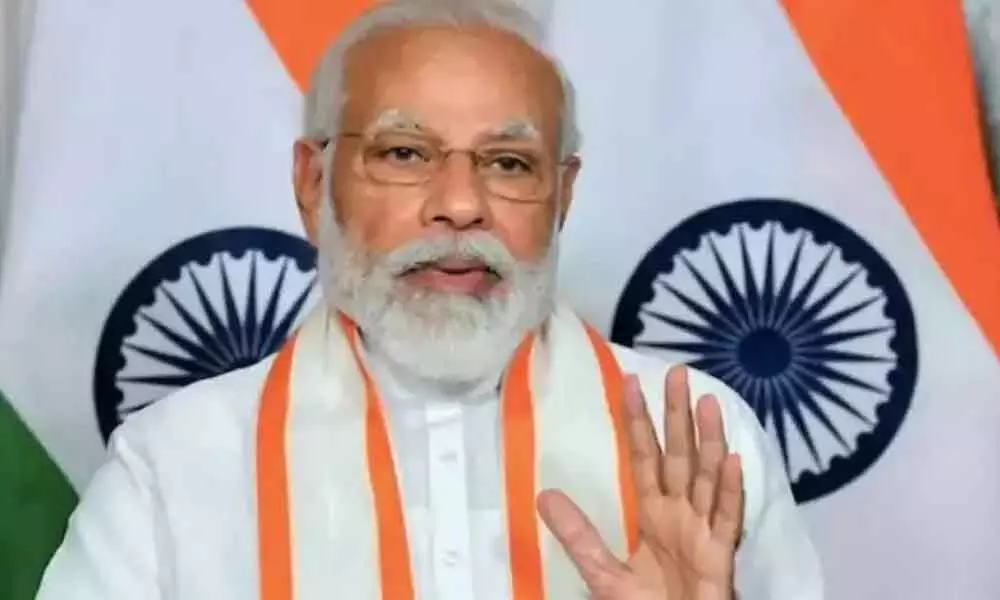Live
- Delhi HC grants bail to three accused in IB staffer Ankit Sharma's murder case
- Mahindra Auto sells 41,008 SUVs in India in April, registering 18 pc growth
- Pitch for India vs Pakistan ICC T20 World Cup 2024 match installed
- Playback Singer Uma Ramanan Passes Away
- Omar Abdullah says BJP trying to divide people on religious lines
- Kamakshi Bhaskarla wins Best Actress Jury Award at Dada Saheb Phalke Film Fest 2024
- Akums Drugs launches DCGI-approved meds for treatment of resistant high BP
- Janhvi Kapoor turns host for Sridevi's Chennai home, says it was her 'prized possession'
- CM Stalin cuts short his holiday in Kodaikanal, to return to Chennai today
- Khammam: Congress draws public ire; BRS all set to triumph
Just In
Modi's Govt. Wants More Cars to Run on Ethanol, Made from Sugar


Prime Minister Narendra Modi
India would now permit production of ethanol-based flex engines too. The higher use of biofuels in the transport sector will help ease India’s economic burden from high crude prices and it will also help the 3rd largest oil importer to save nearing to $4 billion each year, as per the government estimates
The Modi's government plans to have a fast-track ethanol program; the above program would divert nearing to six million tons of sugar toward fuel production annually by the year, 2025, as per the food ministry. That is almost, the entire amount, which India, which holds the record of world's 2nd biggest producer only next to Brazil, India; presently export that much amount of sugar in the global market.
India's is pushing for more number of cars on ethanol made from sugar; this move may increase the risk of raising the cost of the sweetener globally.
Narendra Modi, the Indian Prime Minister advanced in June a target for blending 20% ethanol in gasoline to 2025, 5 years earlier than planned. Its advantages are multifold, it would help in reducing the air pollution, cut India's oil import bills and also it will help soak up a domestic sugar glut and at the same time increase investment in the rural areas.
When it comes to the rest of the world, this above move might be biggest change in the recent years for the sugar industry and this might help drive a bull market, according to Czapp Czarnikow's new portal for Agri-food analysis. We find, the prices have been soared to the highest, since the year, 2017 amid a supply crunch, partly because of wild weather in Brazil. A further increase would add to food inflation risks, having global food cost already near a decade high.
For the world, it is a good news, if our nation, can divert its attention to produce more amount of ethanol and this would help reduce the global surplus, stated Rahil Shaikh, MD of Meirs Commodities India Pvt, trading company. But eventually, if there is higher demand, few nations such as India would require to expand cane acreage.
To meet its 2025 target, the India would required to almost triple ethanol production to about 10 billion liter a year, as per the nation's oil secretary Tarun Kapoor. This would require about $7 billion of investment as well as the challenge would be create that kind of capacity required in a short period, nearing to 3 to 4 years.
The Indian government is providing financial support to sugar mills in order to set up or expand distilleries. Companies such as Balrampur Chini Mills Ltd would stop producing the sugar at few mills and would begin processing cane juice, so that it can make ethanol instead.
Brazilian model
Our nation, India would like to follow a similar strategy like Brazil, which has been successfully promoted sugar-cane based ethanol for more than forty years to ease it sugar glut, it has cut its dependency on oil imports and increased energy security. Today, Brazil owns the largest fleet of flex fuel cars, which run on any blend of ethanol and gasoline.
India would now permit production of ethanol-based flex engines too. The higher use of biofuels in the transport sector will help ease India's economic burden from high crude prices and it will also help the 3rd largest oil importer to save nearing to $4 billion each year, as per the government estimates.
The above move would help kill two birds with single stone, stated Michael McDougall; New York based managing Director of Paragon global Markets. The above move is in the right direction.
The above move would also help in cutting the India's export subsidies by about $500 million. The government helps cash-strapped mills to boost shipments as a way to support the local prices and also to increase export competitiveness. Rivals nations including the Australia and Brazil, both, have complained about the subsidies to the World Trade Organization.
India, this year, is all set to export nearing to record amount of sugar again with the help of subsidies. Volumes have been forecast at 6.5 million tons.
The surplus would be small after 2025 and the need to export would not remain at such high levels, stated Abinash Verma, the director general of Indian sugar Mills Association. Based upon both, the global and domestic prices, there may be still very small quantities of exports, he stated, declining to give a forecast.

© 2024 Hyderabad Media House Limited/The Hans India. All rights reserved. Powered by hocalwire.com






